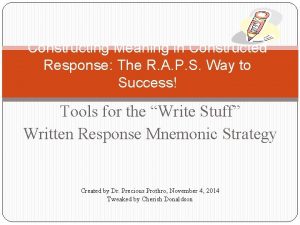Theme Constructed Response Exemplar Theme Constructed Response Required




- Slides: 4

Theme Constructed Response Exemplar

Theme Constructed Response • Required Elements of a Theme Development Constructed Response • • Restate Answer Cite Explain Summarize • Remember to state what aspect of the text you are analyzing to figure out theme. • Character’s thoughts • Character’s actions • Etc.

The Boy Who Cried Wolf: Theme Response The theme of “The Boy Who Cried Wolf” is that lying to others can cause people to not believe you. This is developed in the story through the boys actions, particularly when the little boy lied multiple times resulting in him losing the trust of those around him. He lied to the shepherd crying “WOLF! A wolf is attacking the town!”. When the shepherd came to help, the boy laughed at him. Later on, the boy also lied to the farmer telling him that there was a wolf attacking the town. The farmer “grabbed his pitchfork and ran to defend the town” only to discover that there was no wolf. Both men are mad at the boy for lying to them and tricking them into thinking that there was a wolf. At the end of the story when there actually is a wolf attacking both men ignore the boy’s cries for help. “As the wolf ate all of his father’s chickens, the boy screamed over and over again, “WOLF! Please help us!” But nobody came to help him. ” The implication is that neither shepherd nor farmer believes the boy as he has lied to them previously. These events illustrate that lying to others can cause them to stop believing you even when you are telling the truth.

The Boy Who Cried Wolf: Theme Response Restate, Answer, Cite, Explain, Summary The theme of “The Boy Who Cried Wolf” is that lying to others can cause people to not believe you. This is developed in the story through the boys actions, particularly when the little boy lied multiple times resulting in him losing the trust of those around him. He lied to the shepherd crying “WOLF! A wolf is attacking the town!”. When the shepherd came to help, the boy laughed at him. Later on, the boy also lied to the farmer telling him that there was a wolf attacking the town. The farmer “grabbed his pitchfork and ran to defend the town” only to discover that there was no wolf. Both men are mad at the boy for lying to them and tricking them into thinking that there was a wolf. At the end of the story when there actually is a wolf attacking both men ignore the boy’s cries for help. “As the wolf ate all of his father’s chickens, the boy screamed over and over again, “WOLF! Please help us!” But nobody came to help him. ” The implication is that neither shepherd nor farmer believes the boy as he has lied to them previously. These events illustrate that lying to others can cause them to stop believing you even when you are telling the truth.







